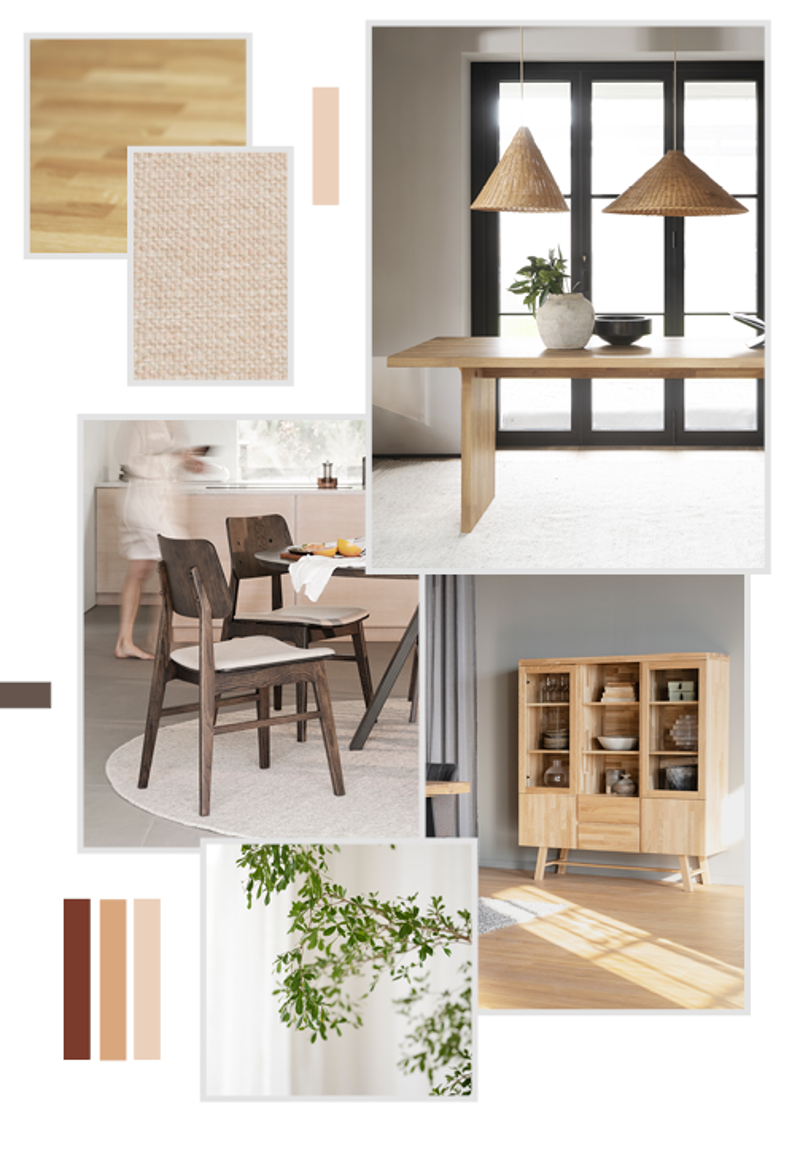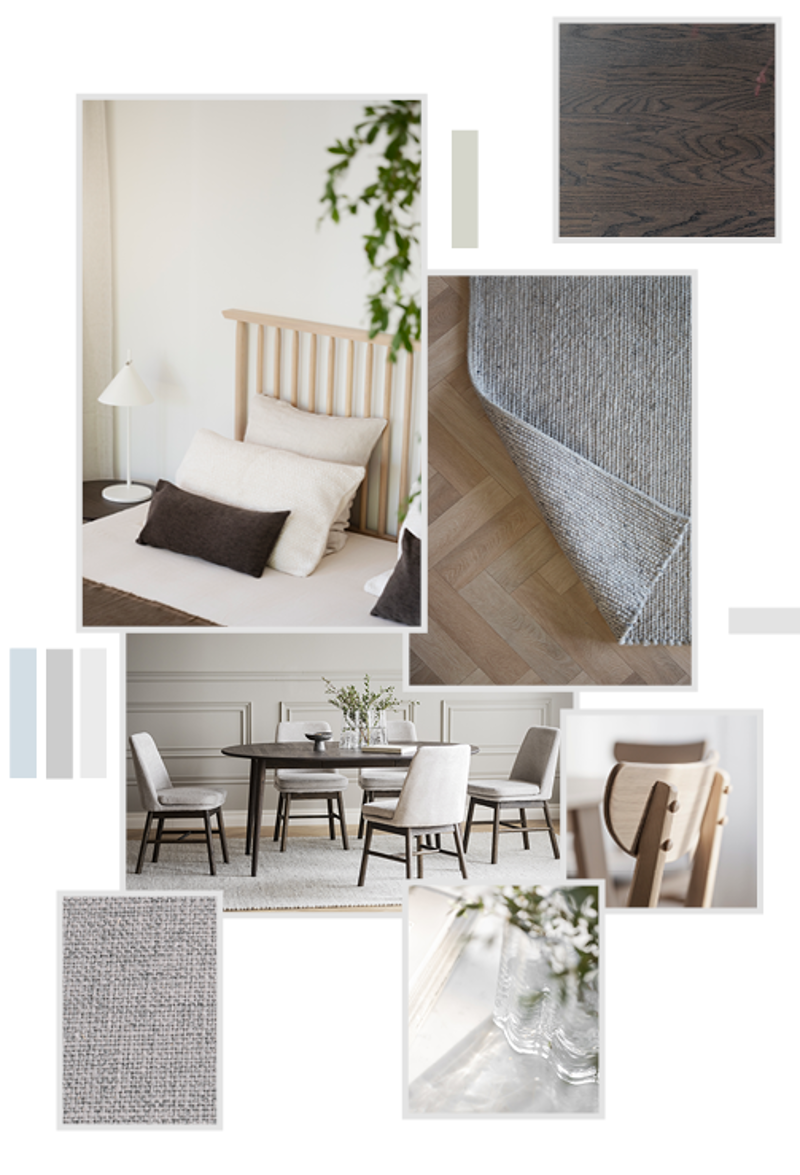

GUIDE COMBINE DIFFERENT TYPES OF WOOD
WHICH WOOD TYPES SUIT YOU?
We answer the questions many ask themselves when it comes to combining different types of wood. Is it okay to mix? What are cold and warm types of wood? Which combinations work best?
CAN YOU MIX DIFFERENT TYPES OF WOOD IN DECOR?
Absolutely! An important factor in creating a personal touch in decor is to use of contrasts. Many are afraid to combine light and dark woods - because the fear that they will not match is perceived as great.
Something that many often forget is that the floor does not have to be the same type of wood as the rest of the decor. To avoid the direct contrast between tables, chairs, and floor, it might be a good idea to place a neutral rug that breaks it up in a nice way and creates a natural place where tables and chairs can be the focus.
Choosing the same type of wood as a common denominator throughout the home may seem like an easy task, but the truth is that it is difficult to find woods that are exactly tone on tone. It is easier to create a nice mix of light and dark wood that complements and lifts each other.
What we think is important to keep in mind when choosing wall paint and furniture is to stick to the same undertone.


WARM OR COLD WOOD TYPES?
When discussing wood types in interior design, there's often talk about warm and cold tones. This division is not just about dark or light wood types, but also about undertones that create different feelings and atmospheres in the home.
It can be a bit tricky to decide if you want your interior to lean more towards warm or cold tones. That's why it's important to listen to yourself and consider your personal opinion. What do you think is most beautiful? What feels most like you and your style? To determine which undertone you prefer, it can sometimes be easiest to look at the furniture you already have and like. Which tone is most representative? Is it warm, cool, or neutral?
WARM WOOD TYPES
Warm wood types have a warm undertone that often leans towards the red, yellow, and orange spectrum. Examples: Brown, ash, and white pigmented
Wood types with warm undertones usually radiate a feeling of warmth with their slightly reddish and golden tones. Warm wood types that go towards the darker brown are often perceived as elegant.
COOL WOOD TYPES
Cool wood types have a cool undertone that often leans towards colors like blue, gray, and purple. Examples: Dark brown and white pigmented.
Wood types with cool undertones are often perceived as minimalist, calm, and simple. The cool wood types often become very light and give a fresh, clean, and airy feeling to the interior.
NEUTRAL WOOD TYPES
So where do black and white furniture land? We would say that these are two neutrals when it comes to furniture and decor.
Black and white will always be just black and white. Two very grateful finishes and colors that can easily be combined with both cool and warm wood types.
COMBINING DIFFERENT WOOD TYPES
To return to the possibility of combining different wood types in decor, there are several ways to create contrasts by matching wood types and colors. Think that the wood types you choose should harmonize with each other without competing. The key to harmonious and well-thought-out decor is often to start from the premises the home has to achieve as cozy and well-thought-out a feel as possible.
Below are some ideas and suggestions on how to combine wood types in decor to create a nice whole and aesthetic. If you want a rule of thumb to follow when it comes to the number of wood colors to combine, we recommend you choose two that you then mix up with textiles and details.
WHITE PIGMENTED AND BROWN IN WARM TONES
A beautiful combination is white pigmented tables together with dark brown chairs with fabric seats creates a naturally nice contrast where both tables and chairs stand out without competing with each other. To enhance the decor add soft textiles and upholstered furniture such as sofas and armchairs, and add pillows and pillowcases with playful patterns and shapes. Then complete with flowers that match the season to give the room additional life and color.
BLACK AND NATURAL OAK WITH COOL UNDERTONES
Oak chairs with a woven seat combined with a black table create an incredibly nice contrast where the different wood colors enhance each other. It is, of course, possible to combine the other way around with a table in natural oak and chairs in black finish.
Dark chairs in black or dark wood in combination with dining tables in white pigmented oak harmonize nicely and create a lovely contrast. Also, the other way around: light chairs in white pigmented oak go well together with a dark brown or black table.

UNIFORM INTERIOR WITH CONTRASTS
It's important to remember that it's not just tables and chairs that can be combined with different types of wood. In the picture above, we see how one can easily create a uniform environment by matching the oak bookshelf with chairs with similar backrests, legs in black metal, seats in a natural gray shade together with a black table, and a neutral rug that softens the expression.
TIPS! Warm wood types go very well with details in brass, and cold wood types are perfectly matched with interior details in chrome.
COMBINE LIGHT WOOD WITH BLACK FOR MORE EFFECT
The ultimate contrast: white pigmented and black. It's an incredibly effective combination of colors and materials. The table has a cool undertone while the chairs are neutral. The black legs of the table facilitate the combination and the chairs naturally blend into the dining room.
If you have a lot of light colors and furniture, it's nice to break it up with a statement color. Black balances and stands out in the decor while giving space to the light colors.
THE ART OF MIXING BLACK WITH COOL SHADES OF BROWN
Black and brown is a style-sure combination that creates contrasts without any of the wood colors becoming dominant. Start by choosing a color combination and then move on to the design of the chair and table. Above, we see the same table with three different chairs, each chair creates a different impression through its design.
OUR RECOMMENDATIONS
- Choose wood types that harmonize with each other without competing.
- Choose an undertone (warm or cool) that is consistent throughout the entire home – instead of just going for the wood type.
- Stick to two different wood shades and then mix with other materials and colors that together create a nice harmony in the decor.
- Smaller details tie the decor together and give a well-thought-out overall impression. e.g., cutting boards, trays, frames, and shelves.
In summary, you can of course mix different types of wood. It provides a nice contrast to the decor that makes the home more lively.
Want to know more about how to take care of your wooden furniture? Read more in our care instructions.




















